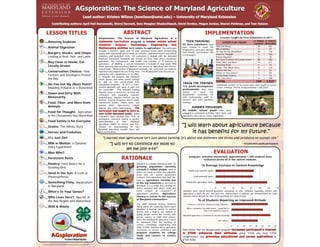A gsploration nacaa 2012 poster
- 1. AGsploration: The Science of Maryland Agriculture is a Lessons Taught by Teen Volunteers in 2011 Amazing Soybean designed to TEEN TRAINING LESSON PLAN TAUGHT # TIMES # YOUTH 55 teen volunteers have TAUGHT REACHED Wild and Wooly 38 641 Animal Digestion as it relates to agriculture. The curriculum been trained to teach the Milk in Motion 3 47 AGsploration curriculum through includes a teacherŌĆÖs guide with 22 peer reviewed lesson plans incorporating Do You Get My (Non)Point? 40 778 Burgers, Steaks, and Chops: inquiry and experiential based hands-on activities, agriculture-based educational their schools, communities, and Food For Thought 5 105 4-H programs. Looking at Beef, Pork, and Lamb materials, and evaluation tools. The curriculum is aligned with the Maryland Animal Digestion 5 78 Voluntary Curriculum Standards and focuses on three main areas: production Buy Close to Home, Eat Locally Grown 28 508 agriculture, the environment, and health and nutrition as it pertains to Buy Close to Home, Eat agriculture. In addition, a careers component is included to help youth think Food, Fiber, and More 15 611 Persistent Pests 5 73 Locally Grown about pursuing post-secondary degrees and careers in agriculture and science- Grains: The Whole Story 8 218 related fields. While written to Maryland Standards, this curriculum can easily be Send in the Sun 1 23 Conservation Choices: How replicated and adapted for use in any state. The AGsploration team focused on WhatŌĆÖs In Your Genes? 6 331 partnering with stakeholders in an effort Farmers and Developers Protect to integrate this program into Maryland Conservation Choices 1 16 the Bay public, private and home school settings Who Lives Here? 4 108 as well as and out-of-school time TOTAL 159 3,537 Do You Get My (Non) Point? educational programs. In 2011, a multi- TRAIN THE TRAINER Additionally, portions of the lesson plans were taught at various faceted approach was taken to pilot test 112 youth development Modeling Pollution in a Watershed professionals have been events, meetings, and fair to approximately 1,600 youth. the curriculum. This included training fifty-five teens as instructors to teach the trained to teach the Down and Dirty With curriculum and expanding outreach AGsploration curriculum via Biosecurity programming. Another element was the web conferencing, staff in- Summer Science Programs where youth services, and state volunteer Food, Fiber, and More from experienced lessons, visited farms, and trainings. learned about agro-science related Animals degrees and career opportunities. SUMMER PROGRAMS 80 middle school youth have been Food for Thought: Agriculture engaged in curriculum activities, farm visits, and Initial in the Chesapeake Bay Watershed evaluation data showed that 75% of agriculture and science career exploration. participants indicated having a greater Food Safety is for Everyone understanding of how Maryland agriculture relates to science and 74% Grains: The Whole Story showed an understanding of how Maryland agriculture benefits them and Horses and Evolution their communities. ItŌĆÖs Just Dirt Milk in Motion: a Dynamic ~ AGsploration youth participants Dairy Experiment Moo Who? Using pre- and post-assessment, approximately 1,500 students were Persistent Pests evaluated across all of the content modules. Poultry: Feed Basics for a Maryland is a rapidly urbanizing state. Its % Average Increase in Content Knowledge Growing Bird growing population currently exceeds 5 million people, most of Health and nutrition topics whom are living in urban and suburban Send in the Sun: A Look at areas and are several generations Photosynthesis removed from agriculture and farm life. Environmental topics Even so, agriculture remains one Something Fishy: Aquaculture of the top industries in the state of Production agriculture topics in Maryland Maryland. It is a major force driving the 0 10 20 30 40 50 60 70 stateŌĆÖs economy and affects each and WhatŌĆÖs In Your Genes? every resident as consumers of Students were asked several questions pertaining to their attitudes regarding science and agricultural products. Agriculture agriculture in both the pre- and post-test. Improvement in attitude was demonstrated for each literacy is crucial to the success question asked. Results for four of the questions are shown below. Who Lives Here? Species of of Maryland communities. % of Students Reporting an Improved Attitude the Bay Region and Watershed Percent┬ĀIncrease The 2009 National Science Academy ŌĆ£Science is useful for solving everyday problems.ŌĆØ "Science is useful for solving everyday problems." Wild & Wooly Rising above the Gathering Storm report ŌĆ£When II graduate from high school, II would like to identified a marked decline in science "When graduate from high school, would like to literacy and a drop in the number of have a job related to science." related to science.ŌĆØ have a job young people across the country who "Maryland agriculture is beneficial to me and my ŌĆ£Maryland agriculture is beneficial to me and my family.ŌĆØ family." pursue careers in math and science. Since the teaching of agriculture cannot ŌĆ£I like science.ŌĆØ be separated from the teaching of "I like science." science, technology, engineering, and 0 5 10 15 20 25 30 35 math (STEM), learning about agriculture contributes to science proficiency and Data shows that the AGsploration program prepares students for college about STEM and their STEM study and careers in science competencies, and in fields. STEM fields. "It is the policy of the University of Maryland, Agricultural Experiment Station and University of Maryland Extension, that no person shall be subjected to discrimination on the grounds of race, color, gender, religion, national origin, sexual orientation, age, marital or parental status, or disability."

